Click on images to enlarge

habit of mature tree (Photo: Forest and Kim Starr, USGS)

habit of younger tree (Photo: Sheldon Navie)
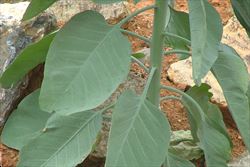
younger stem and lower leaves (Photo: Sheldon Navie)
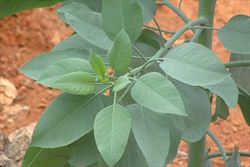
young leaves (Photo: Sheldon Navie)

close-up of leaf underside (Photo: Sheldon Navie)
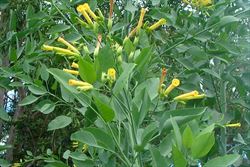
upper leaves and flower clusters (Photo: Sheldon Navie)
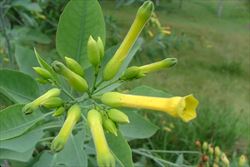
flower buds (Photo: Sheldon Navie)

close-up of flowers (Photo: Sheldon Navie)
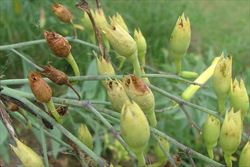
immature and mature fruit (Photo: Sheldon Navie)
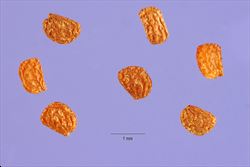
close-up of seeds (Photo: Steve Hurst at USDA PLANTS Database)

seedling (Photo: Sheldon Navie)

young plant (Photo: Sheldon Navie)
Scientific Name
Nicotiana glauca Graham
Family
Solanaceae
Common Names
mustard tree, tobacco bush, tobacco plant, tobacco tree, tree tobacco, wild tobacco
Origin
Native to South America (i.e. Argentina, Brazil, Bolivia, Ecuador, Peru, Chile, Paraguay and Uruguay).
Naturalised Distribution
This species is very widely naturalised in Australia, particularly in the eastern and southern parts of the country. It is common in many parts of Queensland, throughout most of New South Wales and South Australia, and in western Victoria. Relatively common in the southern parts of Western Australia and the southern parts of the Northern Territory. Also present in the ACT, and in other parts of Western Australia and Victoria.
Widely naturalised overseas in Europe, sub-Saharan Africa, temperate Asia, New Zealand, the USA, Mexico and Hawaii.
Notes
Tree tobacco (Nicotiana glauca) is regarded as an environmental weed in Victoria, South Australia, Western Australia, Queensland, New South Wales and the Northern Territory. It grows in a wide variety of open and disturbed habitats, but is mainly a problem in drier inland regions in the southern parts of the country.
However, in South Australia it is a common environmental weed in the Adelaide region and is also a common weed of coastal areas throughout the Gulf St. Vincent area. Tree tobacco (Nicotiana glauca) has also been recorded in numerous conservation areas in this state (e.g. in Coffin Bay National Park, Naracoorte Caves Conservation Park, Aldinga Scrub Conservation Park, Cleland Conservation Park, Winninowie Conservation Park and Kyeema Conservation Park).
In Victoria, tree tobacco (Nicotiana glauca) is regarded as a serious threat to one or more vegetation formations. It has also been recorded in conservation areas in Victoria (i.e. Barkindji Biosphere Reserve and You Yangs Regional Park) and western New South Wales (i.e. Kinchega National Park, Tarawi Nature Reserve and Sturt National Park).
Tree tobacco (Nicotiana glauca) is a weed of arid wetlands in the southern parts of the Northern Territory. This species is abundant and conspicuous along the middle and lower parts of the Finke River system and is also present in the floodplain forests in this catchment. However, it does not form dense stands and does not significantly impact on native species in this region.
In Queensland, tree tobacco (Nicotiana glauca) is listed as an environmental weed in Ipswich City. In Western Australia this species is mainly a weed of roadsides, wastelands and bushland in the south-western parts of the state. However, it is spreading and was recently introduced into the Shark Bay area, where it is thought to pose a threat to biodiversity by competing with native species for resources and displacing native plants. It is also ranked as a minor environmental weed in the Environmental Weed Strategy for Western Australia.
Note: tree tobacco (Nicotiana glauca) is known to hybridise with several closely related native species (i.e. Nicotiana suaveolens, Nicotiana simulans and Nicotiana goodspeedii). The progeny of the Nicotiana glauca and Nicotiana suaveolens cross, which occurs in Victoria, is known as Nicotiana x flinderiensis.

